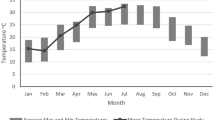Abstract
Examination of the patterns of distribution for five catarrhine genera (Gigantopithecus, Pongo, Hylobates, Macaca, andRhinopithecus) during the Pleistocene and Holocene in China indicates that the geographical ranges of individual genera shifted independently of one another in response to conditions of increasing seasonality. All genera examined saw their distributions shift southward, with the shifting subtropical and tropical zones, during the Pleistocene. This occurred earlier in the Pleistocene for the larger apes, and later for smaller forms. This apparent paradox is readily explained by the inability of large-bodied apes to satisfy the high metabolic demands of a relatively large brain as well as those of an absolutely larger body. Monkeys were somewhat less affected and their greater relative success is attributed to their abilities to survive in more highly seasonal environments by exploiting a wider variety of plant foods and to produce offspring more quickly, thanks to shorter gestation times and shorter interbirth intervals.
Similar content being viewed by others
References
An, Z. S.;Wu, X. H.;Lu, Y. C.;Zhang, D. E.;Sun X. J.;Song, G. R.;Wang, W. M. 1991. Paleoenvironmental changes of China during the last 18,000 years. In:Quaternary Geology and Environment in China,Liu,T. S. (ed.), Science Press, Beijing, pp. 228–236.
Cui, Z. J.;Song, C. Q. 1991. Quaternary periglacial environment in China. In:Quaternary Geology and Environment in China,Liu,T. S. (ed.), Science Press, Beijing, pp. 78–85.
Ferguson, D. 1993. The impact of late Cenozoic environmental changes in East Asia on the distribution of terrestrial plants and animals. In:Evolying Landscapes and Evolving Biotas of East Asia Since the Mid-Tertiary,Jablonski,N. G. (ed.), Centre of Asian Studies (Univ. of Hong Kong), Hong Kong, pp. 145–196.
Graham, R. W.;Lundelius, E. L.;Graham, M. A.;Shroeder, E. K.;Toomey, R. S.;Anderson, E.;Barnosky, A. D.;Burns, J. A.;Churcher C. S.;Grayson, D. K.;Guthrie, R. D.;Harington, C. R.;Jefferson, G. T.;Martin, L. D.;McDonald, H. G.;Morlan, R. E.;Semken, H. A.;Webb, S. D.;Werdelin, L.;Wilson, M. C. 1996. Spatial response of mammals to late Quaternary environmental fluctuations.Science, 272: 1601–1606.
Gu, Y. M. 1986. Preliminary research on the fossil gibbon of Pleistocene China.Acta Anthropol. Sinica, 5: 208–219.
Gu, Y. M. 1989. Preliminary research on the fossil gibbons of the Chinese Pleistocene and Recent.Human Evol., 4: 509–514.
Gu, Y. M.;Huang, W. P.;Song, F. Y.;Guo, X. F.;Chen, D. Y. 1987. The study of some fossil orangutan teeth from Guangdong and Guangxi.Acta Anthropol. Sinica, 6: 272–283.
Jablonski, N. G. 1993. Quaternary environments and the evolution of primates in East Asia, with notes on two new specimens of fossil Cercopithecidae from China.Folia Primatol., 60: 118–132.
Jablonski, N. G. 1997. The relevance of environmental change and primate life histories to the problem of hominid evolution in East Asia. In:The Changing Face of East Asia During the Tertiary and Quaternary,Jablonski,N. G. (ed.), Centre of Asian Studies (Univ. of Hong Kong) Hong Kong, pp. 461–474.
Kahlke, H. D. 1973. A review of the Pleistocene history of the orang-utan (Pongo Lacépède 1799).Asian Perspectives, No. 15, pp. 5–14.
Li, W. Y. 1991. Vegetation and environment of the Quaternary in China. In:Quaternary Geology and Environment in China,Liu,T. S. (ed.), Science Press, Beijing, pp. 151–157.
Pan, Y. R.;Jablonski, N. G. 1987. Age and geographical distribution of fossil cercopithecids in China.Human Evol., 2: 59–69.
Winkler, M. G.;Wang, P. K. 1993. The Late-Quaternary vegetation and climate of China. In:Global Climates Since the Last Glacial Maximum,Wright,H. E. (ed.), Univ. of Minnesota Press, Minneapolis, pp. 221–264.
Zhou, Y. W.;Qiu, G. Q.;Guo, D. X. 1991. Changes of permafrost in China during Quaternary. In:Quaternary Geology and Environment in China,Liu,T. S. (ed.), Science Press, Beijing, pp. 86–94.
Author information
Authors and Affiliations
About this article
Cite this article
Jablonski, N.G. The response of catarrhine primates to pleistocene environmental fluctuations in East Asia. Primates 39, 29–37 (1998). https://doi.org/10.1007/BF02557741
Received:
Accepted:
Issue Date:
DOI: https://doi.org/10.1007/BF02557741




